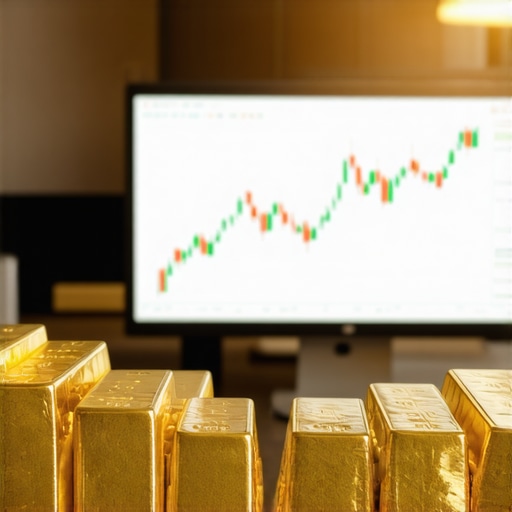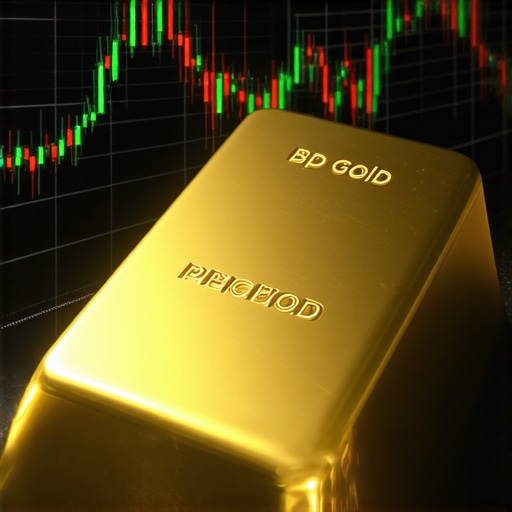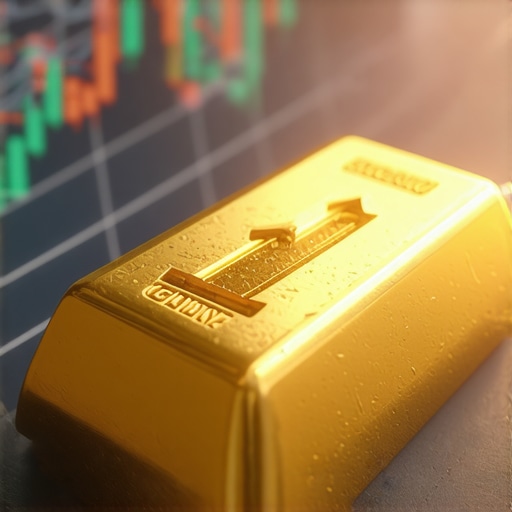Exploring the Connection Between Geopolitical Events and Gold Prices
Gold has long been considered a safe haven asset, and its price is significantly influenced by geopolitical events around the world. As investors seek stability during times of uncertainty, the demand for gold often increases, leading to fluctuations in its price. Understanding how geopolitical tensions affect gold prices can help investors make informed decisions about their investments.
The Role of Uncertainty in Driving Gold Demand
In times of political instability, economic distress, or military conflicts, investors tend to flock to gold as a hedge against risk. For instance, recent conflicts in various regions have led to spikes in gold prices as traders seek to protect their wealth. This behavior is rooted in the historical perspective of gold as a reliable store of value, particularly during crises.
Case Studies of Geopolitical Events Impacting Gold Prices
Several key events have shaped the relationship between geopolitical occurrences and gold prices:
- The 2008 Financial Crisis: The global financial meltdown triggered a surge in gold prices as investors lost faith in traditional assets like stocks and bonds. Gold reached record highs as it was viewed as a safe investment.
- Middle East Conflicts: Ongoing tensions in the Middle East have historically led to fluctuations in gold prices. For example, during the Iraq War, gold prices experienced significant increases due to concerns about global stability.
- Trade Wars: Recent trade tensions between major economies have also influenced gold prices. As tariffs and sanctions create economic uncertainty, gold often benefits from increased demand as a safe haven.
How Global Events Shape Market Sentiment
The perception of risk is crucial in determining gold prices. Geopolitical events can lead to changes in market sentiment, impacting investor behavior. For instance, when news of a potential conflict arises, many investors may rush to buy gold, anticipating a downturn in the stock market or the economy. This rush can create a spike in demand, pushing prices higher.
Conclusion: The Importance of Monitoring Geopolitical Trends
Investors in gold should stay informed about global geopolitical developments, as these events can have profound impacts on market dynamics. Understanding the historical context and current trends can provide valuable insights for making smarter investment decisions. As the world continues to face political and economic challenges, the demand for gold will likely remain a critical factor in shaping its price.
Understanding Economic Indicators That Influence Gold Prices
In addition to geopolitical events, various economic indicators play a crucial role in shaping gold prices. Investors must be aware of these factors as they can significantly impact market dynamics and investment strategies.
The Impact of Inflation on Gold Prices
Inflation is one of the most significant indicators that influence gold prices. As the cost of living rises, the purchasing power of currency decreases, making gold an attractive alternative. Historically, during periods of high inflation, gold has acted as a hedge, preserving wealth against the eroding value of paper money. This relationship is particularly relevant today as many economies face rising inflation rates.
Interest Rates and Their Effect on Gold
Another critical economic factor is interest rates. Central banks regulate interest rates to control inflation and stabilize the economy. When interest rates are low, the opportunity cost of holding gold diminishes, leading to increased demand for the metal. Conversely, higher interest rates can make gold less appealing as an investment, as yields from other assets become more attractive. Therefore, monitoring changes in monetary policy is essential for gold investors.
Employment Data and Economic Growth
Employment statistics are also vital indicators of economic health. A strong job market typically correlates with economic growth, which can negatively impact gold prices. As confidence in economic stability increases, investors may prefer riskier assets over gold. Conversely, poor employment data can signal economic weakness, prompting a shift back to gold as a safe haven. Understanding these trends can help investors gauge when to enter or exit gold positions.
The Relationship Between Currency Strength and Gold Prices
The strength of the U.S. dollar is another critical factor affecting gold prices. Gold is priced in dollars, meaning that a stronger dollar usually results in lower gold prices, while a weaker dollar tends to push gold prices higher. Investors should keep an eye on currency movements and economic reports that might indicate shifts in the dollar’s value. For instance, during times of dollar depreciation, many investors turn to gold to protect their wealth.
How Global Economic Events Influence Gold Trading
Global events, such as economic crises or changes in trade policies, can profoundly impact gold prices. For example, during the COVID-19 pandemic, gold prices surged as investors sought safety amidst unprecedented uncertainty. Additionally, trade agreements or tariffs can influence commodity prices, including gold. Understanding these global economic factors is crucial for making informed investment decisions in the gold market.
Conclusion: The Need for Comprehensive Market Analysis
To effectively navigate the gold market, investors must consider a range of economic indicators and global events. By staying informed about inflation, interest rates, employment data, and currency strength, investors can make more strategic decisions regarding their gold investments. As economic conditions continue to evolve, the importance of understanding these factors will only grow, ensuring that gold remains a vital component of a diversified investment portfolio.
Understanding the Gold Market Dynamics
As we look towards 2025, grasping the intricate dynamics of the gold market becomes essential for investors. Various factors, including political stability, inflation rates, and economic recovery patterns, will shape the future of gold investments. With the ongoing fluctuations in these areas, being well-informed is crucial for making strategic decisions in gold trading.
The Role of Geopolitical Stability in Gold Valuation
Geopolitical events continue to play a pivotal role in driving gold prices. For instance, tensions in major regions can lead to a surge in gold demand as investors seek safe-haven assets. Uncertain political climates often result in market volatility, making gold an appealing investment option. As we analyze the impact of global demand on gold prices, it’s clear that political unrest can significantly benefit gold valuations.
Understanding Demand and Supply in the Gold Market
The fundamental principles of supply and demand hold significant influence over gold pricing. When demand exceeds supply, prices typically rise. In contrast, an oversupply can lead to price declines. Tracking the trends of gold mining output and recycling rates is essential for investors looking to optimize their portfolios. For insights into these dynamics, refer to our guide on gold supply and demand.
Technological Innovations and Their Impact on Gold Investments
Advancements in technology have also begun to reshape the gold market. Innovations such as blockchain technology and digital gold currencies are emerging as new investment avenues. These developments can potentially alter traditional investment strategies, offering new ways to invest in gold. Being aware of such trends can empower investors to stay ahead of the curve in a rapidly evolving market.
Gold as a Hedge Against Economic Uncertainty
Gold has long been viewed as a hedge against economic instability. As inflation rises and economic forecasts become uncertain, many investors turn to gold to safeguard their wealth. For those looking to understand how gold serves as a protective asset, our article on gold as a hedge against financial crises provides valuable insights.
Key Strategies for Investing in Gold in 2025
With the landscape of gold investing constantly changing, adopting effective strategies is crucial for achieving optimal returns. Diversification is a key principle; investors should not only consider physical gold but also explore gold ETFs and mining stocks. This approach allows investors to balance risk and reward effectively. For beginners, our guide to investing in gold outlines essential strategies for successful investing.
Conclusion: Preparing for the Future of Gold Investments
As we look ahead to 2025, the interplay of various economic indicators, geopolitical events, and technological advancements will continue to shape the gold market. By staying informed and adapting to these changes, investors can navigate the complexities of gold trading and capitalize on the opportunities that arise. Understanding these factors is not just about making informed decisions; it’s about securing a profitable future in the ever-evolving landscape of gold investments.
Exploring Gold Investment Vehicles for 2025
As we advance into 2025, investors must familiarize themselves with the various gold investment vehicles available. From physical gold to gold-backed exchange-traded funds (ETFs) and mutual funds, understanding the differences can lead to better investment decisions. Each type offers unique benefits and risks, catering to different investment strategies and preferences. For instance, investing in physical gold allows for tangible asset ownership, while gold ETFs offer liquidity and ease of trading.
Physical Gold: Pros and Cons
Investing in physical gold, including bars and coins, is often seen as a traditional approach. One of the significant advantages is the intrinsic value of gold, which tends to hold its worth across economic fluctuations. However, the drawbacks include storage costs and potential liquidity issues. For insights on maximizing your physical gold investments, check out our article on maximizing your gold bar investments.
Gold ETFs: A Modern Investment Approach
Gold ETFs provide an excellent alternative for those looking to invest without the hassles of physical ownership. These funds track the price of gold and are traded on major stock exchanges like stocks. They offer liquidity and diversification, making them an attractive option for new investors. Understanding how to evaluate gold ETFs is crucial; you can find guidance in our post about what to look for in gold ETFs.
Mutual Funds and Gold Mining Stocks
Investing in mutual funds that focus on gold and gold mining companies allows investors to gain exposure to the gold sector without directly purchasing gold itself. These funds can offer professional management and diversification across various gold assets. However, they also come with management fees and may not always reflect the price of gold. For a comprehensive understanding of gold mining stocks, you might want to read our article on investing in gold mining stocks.
Trends Shaping the Future of Gold Investments
As the gold market evolves, several trends are beginning to take shape. The rise of digital assets and cryptocurrencies has sparked discussions about the future of gold as a store of value. Additionally, increasing global demand for gold, particularly from emerging markets, continues to influence prices. Staying updated on these trends is vital for making informed investment choices. For those interested in market predictions, our article on gold price forecasts for 2025 provides valuable insights.
Conclusion: Making Informed Gold Investment Choices
As we look forward to 2025, the landscape of gold investing is becoming increasingly complex. By understanding the different investment vehicles available and staying informed about market trends, investors can navigate this dynamic environment effectively. Whether choosing physical gold, ETFs, or mining stocks, being equipped with knowledge is essential for making sound investment decisions in gold.
Frequently Asked Questions About Gold Investment
What are the benefits of investing in gold?
Investing in gold offers several benefits, including a hedge against inflation, portfolio diversification, and potential for capital appreciation. Gold is often viewed as a safe haven during economic uncertainties, making it a popular choice among investors.
How do gold ETFs differ from physical gold investments?
Gold ETFs are funds that track the price of gold and are traded like stocks on exchanges, providing liquidity and ease of access. In contrast, physical gold investments involve buying gold bars or coins, which require storage and security considerations.
What are the risks associated with gold investments?
While gold can be a stable investment, it is not without risks. These include market volatility, price manipulation, and potential lack of liquidity for physical gold. Investors should be aware of these factors and consider their risk tolerance when investing in gold.
How can I evaluate gold mining stocks?
Evaluating gold mining stocks involves analyzing the company’s financial health, production costs, reserves, and management team. Investors should also consider broader market conditions and gold price trends that can impact the profitability of mining companies.
Is it better to invest in gold funds or individual gold stocks?
Investing in gold funds, such as ETFs or mutual funds, can provide diversification and professional management, reducing individual stock risk. However, individual gold stocks may offer higher returns if the company performs well. The choice depends on the investor’s risk appetite and investment goals.
What is the outlook for gold prices in 2025?
While predicting gold prices can be challenging, many analysts suggest that factors such as economic instability, inflation rates, and global demand will influence gold prices in 2025. Staying informed about market trends is crucial for making educated predictions.
Can I invest in gold through my retirement account?
Yes, many retirement accounts allow for gold investments, particularly through self-directed IRAs. This enables investors to hold physical gold or gold-related assets within their retirement portfolios, providing tax benefits and diversification.
What are the tax implications of selling gold?
When selling gold, investors may be subject to capital gains tax on any profits made. The tax rate can vary based on how long the gold was held and the investor’s income level. It’s advisable to consult a tax professional for personalized guidance.
How do I start investing in gold?
To start investing in gold, first, determine your investment goals and risk tolerance. Research different gold investment vehicles, such as physical gold, ETFs, and mining stocks. Finally, choose a reputable broker or dealer to execute your investment strategy.
Authority Resources for Gold Investment
For those interested in deepening their understanding of gold investments, several authoritative resources can provide valuable insights:
- Investopedia – Gold Investment Guide: A comprehensive resource covering various aspects of gold investing, including strategies and market analysis.
- Kitco – Precious Metals Information: Offers real-time gold prices, market news, and educational articles on gold investment.
- World Gold Council: A leading authority on gold, providing research, industry news, and insights into gold’s role in the global economy.
- BullionVault – Gold Investment Platform: A platform for buying and selling physical gold, providing market insights and investment resources.
- Finviz – Financial Visualization: A stock screener and market analysis tool that includes gold mining stocks, offering insights for investors.
- Morningstar – Investment Research: Provides in-depth analysis and ratings on gold ETFs and mutual funds, helping investors make informed decisions.
Conclusion: Embracing Gold Investment Opportunities
As we navigate the complexities of gold investment in 2025, understanding the various investment vehicles, market trends, and risks is crucial. Whether you opt for physical gold, ETFs, or mining stocks, being informed will empower you to make sound investment choices. By leveraging the provided FAQ and authoritative resources, you can enhance your gold investment strategy and potentially capitalize on the opportunities that lie ahead.










